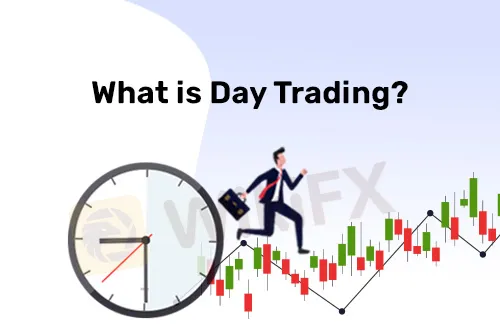简体中文
繁體中文
English
Pусский
日本語
ภาษาไทย
Tiếng Việt
Bahasa Indonesia
Español
हिन्दी
Filippiiniläinen
Français
Deutsch
Português
Türkçe
한국어
العربية
How to Day Trade on Robinhood? Features, Strategies, Mistakes to Avoid
Abstract:Day trading is a disciplined form of trading where investors buy and sell financial assets same trading day. The goal is to profit from small price movements in highly liquid stocks or currencies. This approach contrasts with long-term investment strategies, requiring a comprehensive understanding of market trends, technical analysis, and the psychological fortitude to make rapid and samrt decisions.
What is Day Trading?
Day trading is a disciplined form of trading where investors buy and sell financial assets same trading day. The goal is to profit from small price movements in highly liquid stocks or currencies. This approach contrasts with long-term investment strategies, requiring a comprehensive understanding of market trends, technical analysis, and the psychological fortitude to make rapid and samrt decisions.

Here is a typical day trading example:
A day trader named Alex focuses on a tech stock that's been volatile recently. Before the market opens, Alex reviews the stock's performance, noting a strong earnings report released after the market closed yesterday. Anticipating an uptick in price due to positive investor sentiment, Alex buys 100 shares at the opening bell when the stock is priced at $150 per share. As predicted, the stock's price rises throughout the morning, driven by high volume and positive news coverage. By midday, the stock reaches $155 per share. Seeing the momentum start to wane and aiming to capitalize on the gains, Alex sells all 100 shares at this price. In a few hours, Alex has made a profit of $500 (excluding any applicable fees or taxes) by leveraging market dynamics and timely execution, showcasing the essence of day trading.
Overview of Robinhood & Day Trading on Robinhood
 |
|
| Founded in | 2013 |
| Min. Deposit | $0 |
| Products | stocks, ETFs, cryptocurrency, and options |
| Trading Platform | Robinhood Platform |
| Payment Methods | Visa, Mastercard, Robinhood Cash Card |
| Customer Support | 7/24 |
Robinhood, established in 2013, is a known broker firm based in the U.S, offering commission-free trading on Stocks, ETFs, Options, ADRs, and Cryptocurrencies through its easy-to-use mobile app and web-based platform. Regarding customer support, Robinhood mainly provides 5/24 customer support via email and has an extensive FAQ section.
Robinhood's impact on day trading is significant and profound. Robinhood has democratized stock trading, removing traditional barriers to entry such as high fees and complex trading platforms. It employs intuitive and mobile first platform with an easy-to-use interface, plus a commission-free trading policy which attracts budget-conscious traders, appealing to a broader audience, from novices to seasoned traders. These features cater to the essential needs of day traders, who rely on speed and efficiency to capitalize on small price movements within short timeframes, effectively enhancing their ability to engage in the market.

✅ Where Robinhood Shines:
• Robinhood feaures a zero-commission trading policy for stocks, options, ETFs, and cryptocurrencies, appealing to cost-conscious users.
• Its user-friendly mobile platform is appreciated by the new generation of tech-savvy traders.
• Robinhood offers extended trading hours, giving users more flexibility to trade according to their schedule.
• Allow for fractional share trading, ideal for younger generations and first-time investors.
❌ Where Robinhood Shorts:
• Unlike more traditional brokers, Robinhood lacks comprehensive advanced charts, research tools, and detailed market analysis.
• Robinhood only offers individual taxable accounts and lacks individual retirement account (IRA) options.
• Robinhoods customer support, primarily provided through email, can be slow to respond, leading to user dissatisfaction.
Using Robinhood for Day Trading
Using Robinhood for day trading has become increasingly popular among retail traders on account of its user-friendly interface, commission-free trades, and mobile accessibility. However, leveraging Robinhood effectively for day trading requires understanding its unique features and limitations. Here we explore both advantages and disadvantages of Robinhood day trading.

Advantages of Robinhood for Day Trading
Commission-Free Trades: Robinhood's most appealing feature for day traders is its commission-free trading structure, which allows for frequent trading without the burden of accumulating fees. This is particularly beneficial for strategies that involve making multiple trades a day to capture small price movements.
User-Friendly Interface: The platform's intuitive design makes it accessible for beginners, while still offering enough functionality for more experienced traders. Quick execution and the ease of navigating through different securities facilitate rapid decision-making, a crucial aspect of day trading.
Instant Access to Funds: With Robinhood Instant, traders can access funds immediately after selling stocks, which is essential for maintaining liquidity and the ability to act quickly on market opportunities.
Disadvantages of Robinhood for Day Trading
Pattern Day Trader (PDT) Rule: Robinhood, like all brokers regulated by FINRA, enforces the PDT rule, which limits users to three day trades within a five-day period unless they have at least $25,000 in their account. This can be considered a significant constraint for day traders operating with smaller account balances.
Limited Advanced Tools: While Robinhood offers essential tools for day trading, it lacks the advanced charting and analytical tools available on more specialized platforms. Day traders may need to use additional software for in-depth analysis.
Market Data and Execution Speed: Some users have reported delays in order execution and market data updates. In day trading, where seconds can make a significant difference, any delay in executing trades or receiving information can impact profitability.
Customer Support: Robinhood's customer support is primarily email-based, which might not be as responsive as the direct phone support offered by traditional brokerages. In fast-moving markets, the ability to quickly resolve issues can be critical.
Getting Started with Day Trading on Robinhood
Setting Up Your Robinhood Account
To begin day trading on Robinhood, one must first establish an account. This process involves submitting personal and financial information, passing a verification check, and linking a bank account.

Mastering the Robinhood User Experience
Robinhood's interface is deliberately simple, emphasizing user-friendliness while still offering all necessary features. Users can view live market updates, customize a watchlist of favorite stocks, and carry out trades quickly and easily. Getting to know the app's structure and capabilities is essential for fully leveraging its benefits in day trading.
Understanding Robinhood's Features
Robinhood caters to day traders with features like stop loss orders, limit orders, and real-time notifications. These tools are essential for implementing strategies, managing risks, and staying informed of market movements. However, traders should also be aware of the platform's limitations, such as the absence of advanced charting tools, which might necessitate supplemental resources.
Effective Techniques for Day Trading
Scalping
Scalping involves making numerous small profits on minor price changes. This technique requires quick judgment and execution, as profits can dissipate quickly. Sarah, a day trader practicing scalping, focusing on small profits from minor price changes. She buys 500 shares of a volatile tech stock at $100.25 and sells them shortly after at $100.35, making a $50 profit (excluding costs) from a $0.10 increase. Sarah repeats similar trades throughout the day, leveraging quick, small gains.

Momentum Trading
Momentum trading is based on the premise that assets in motion tend to stay in motion. Traders look for stocks experiencing significant upward or downward trends and attempt to profit from these trends' continuation. An effective momentum trader might enter a trade following a news release that causes a rapid stock price increase, anticipating further rises.

Swing Trading
While traditionally not limited to a single day, swing trading can be adapted for day trading by focusing on trades that might only last a couple of hours to capture larger price movements. This strategy is beneficial for those unable to monitor the markets constantly, relying on more significant, more predictable price movements than those targeted by scalpers.

Risk Management in Day Trading
Setting Stop Loss and Take Profit
Effective risk management is crucial in day trading, where stop loss and take profit orders are invaluable tools. These automated orders can help traders adhere to their strategy, taking emotions out of the decision-making process. For instance, setting a stop loss at a 2% loss and a take profit at a 5% gain can help maintain a favorable risk-reward ratio.
Diversification Matters
While diversification is a cornerstone of risk management in investing, its application in day trading is nuanced. A focused approach, targeting specific sectors or strategies, often yields better results. However, spreading trades across different assets can mitigate risks associated with any single investment.
Psychological Aspects of Trading
Day trading is as much a psychological endeavor as a technical one. Traders must maintain discipline, manage stress, and make decisions devoid of emotional influence. Developing a trading plan and sticking to it, even in volatile markets, can help cultivate the mental resilience required for success.
The Importance of News and Market Sentiments
Staying informed about financial news and market sentiment is critical for day trading. Events such as earnings reports, economic indicators, and geopolitical developments can significantly impact stock prices. Integrating this information into trading strategies can provide a competitive edge.
Utilizing Technical Indicators
Mastering technical indicators such as the Relative Strength Index (RSI) or Moving Average Convergence Divergence (MACD) can enhance decision-making. For example, an RSI reading above 70 might indicate an overbought condition, suggesting a potential sell opportunity.
Common Mistakes to Avoid in Day Trading
Day trading, with its potential for high returns, also comes with a high risk of loss, especially for those who dive in unprepared. Here are some common mistakes for traders to avoid in their day tarding:

Lack of a Trading Plan: Trading without a clear plan is akin to navigating a storm without a compass. A comprehensive trading plan includes defined entry, exit, and money management strategies, tailored to individual risk tolerance and investment goals. It serves as a roadmap, guiding traders through volatile markets and helping to mitigate emotional decision-making.
Overtrading: This occurs when traders, driven by emotion or the desire for increased profits, make more trades than their strategy dictates. Overtrading not only elevates transaction costs but also leads to diminished focus and poorer decision-making. It's crucial to understand that not trading is sometimes the best action.
Ignoring Risk Management: Effective risk management involves setting stop-loss orders to limit potential losses, diversifying trades, and never risking more than a predetermined percentage of the portfolio on a single trade. Successful traders know the importance of preserving capital for future opportunities.
Emotional Trading: Allowing emotions like fear and greed to influence trading decisions can derail even the most thought-out strategies. Emotional trading often leads to entering or exiting trades prematurely or holding onto losing positions for too long. Cultivating emotional discipline and sticking to a trading plan is paramount.
Failing to Keep Records: Without a detailed record of past trades, including the strategy used, entry and exit points, and the trade's outcome, traders miss out on valuable learning opportunities. A trading journal facilitates the review and refinement of strategies, helping traders understand their strengths and weaknesses.
Neglecting Market Research: Basing trades on hearsay or not conducting thorough research can lead to uninformed decisions. Successful day trading requires an understanding of technical analysis, market indicators, and the ability to interpret news and economic data that could affect market movements.
Underestimating Transaction Costs: While individual costs may seem negligible, they can quickly accumulate, particularly for strategies that involve frequent trading, such as scalping. Traders need to account for fees, spreads, and slippage in their profitability calculations.
Chasing Losses: After a losing trade, trying to “make back” lost money by increasing the trade size or frequency is a common pitfall. This often results in further losses. Accepting losses as part of the trading process and maintaining adherence to a tested strategy is crucial for long-term success.
Ignoring External Factors: Economic reports, geopolitical events, and market sentiment can drastically impact market prices. Successful traders stay informed about global events and understand their potential impact on the markets, adjusting their strategies accordingly.
Using Excessive Leverage: Leverage allows traders to control large positions with a relatively small amount of capital, magnifying both gains and losses. Misuse of leverage can lead to significant losses, even exceeding the initial investment. It's important to use leverage judiciously, in line with one's risk management strategy.
Conclusion
In conclusion, day trading on Robinhood presents a user-friendly and cost-effective platform for those eager to dive into rapid, short-term trading activities. However, beware of common pitfalls along the way. By smartly enhancing Robinhood's offerings with extra research and analysis, and sticking to disciplined trading practices, traders indeed have a fantastic opportunity to achieve success in day trading.
FAQs
Is day trading allowed on the Robinhood platform?
Yes, day trading is permitted on the Robinhood platform. However, it's important to note that certain requirements and restrictions apply for pattern day traders, as defined by FINRA regulations.
How do I avoid day trading rules on Robinhood?
To avoid day trading rules on Robinhood, keep your account balance above $25,000 for unlimited trades, or limit your trades to three or fewer within five business days if below this threshold, ensuring compliance while trading.
Is it worth it to day trade?
Indeed, day trading can be rewarding for those with strong market knowledge, risk management, and discipline. Yet, it's risky and not suited for everyone, requiring ongoing learning and adaptability
Disclaimer:
The views in this article only represent the author's personal views, and do not constitute investment advice on this platform. This platform does not guarantee the accuracy, completeness and timeliness of the information in the article, and will not be liable for any loss caused by the use of or reliance on the information in the article.
Read more

WikiFX Elite Club Committee Makes Its Debut, Charting the Future of the Global Trading Ecosystem
November 11, 2025 – The WikiFX Elite Club Committee (hereafter “the Elite Committee”) made its significant debut on the international stage at WikiEXPO Dubai 2025. Core members from the Middle East, Southeast Asia, and Chinese-speaking regions gathered to witness the beginning of a new chapter for the Elite Club.

WikiEXPO Dubai 2025 Concludes Successfully — Shaping a Transparent, Innovative Future
On November 11, WikiEXPO Dubai 2025, hosted by WikiGlobal and co-organized by WikiFX, successfully concluded. As one of the world’s most influential Fintech expos, this event brought together more than 570 regulatory representatives, industry leaders, and innovation pioneers from across the globe. Through in-depth discussions on core issues such as regulatory compliance, the forex market, investment strategies, and sustainable finance, the event delivered a profound experience that masterfully blended intellectual depth with actionable insights.

The 5%ers Review: Is it a Scam or Legit? Find Out from These Trader Comments
Did you face reduced leverage and hiked fees without any explanation from The 5%ers broker? Do you find The 5%er rules strange for getting a funded account from this prop trading firm? Has the broker closed your trade inappropriately, preventing you from making gains in the forex market? All these allegations have dominated The 5%ers review segment online. Looking at this, the WikiFX team investigated and found some startling comments against the broker. In this article, we have shared those complaints. Read on!

BROKSTOCK Exposed: Traders Report Login Errors, Withdrawal Issues & Incompetent Customer Support
Is your BROKSTOCK trading account full of inefficiencies? Do the recurrent BROKSTOCK login errors prevent you from opening and shorting positions at a favorable price? Has the broker failed to honor your withdrawal requests? Do you face order execution price issues? Has the customer support service failed to resolve your queries? You are not alone! In this BROKSTOCK review article, we have shared some complaints that need a close introspection. Read on to explore them.
WikiFX Broker
Latest News
Is Fyntura a Regulated Broker? A Complete 2025 Broker Review
Zetradex Exposed: Withdrawal Denials, Account Freeze & Bonus Issues Hurt Traders
Is Forex Zone Trading Regulated and Licensed?
PINAKINE Broker India Review 2025: A Complete Guide to Safety and Services
Exness Restricted Countries List 2025 Explained
Is Uniglobe Markets Legit? A 2025 Simple Guide to Its Safety, Services, and User Warnings
Is Inzo Broker Safe or a Scam? An Evidence-Based Analysis for Traders
WikiEXPO Dubai 2025 “Welcome Party” Kicks Off Tonight!
He Trusted a WhatsApp Group and Lost RM659,000
Moomoo Singapore Opens Investor Boutiques to Strengthen Community
Currency Calculator



